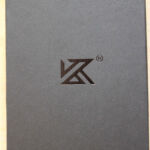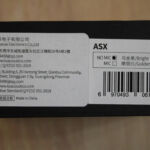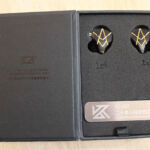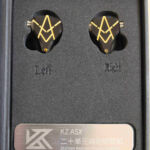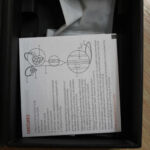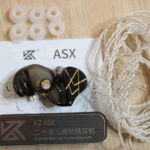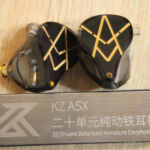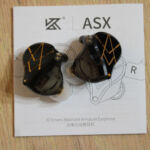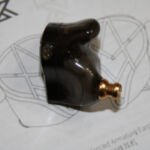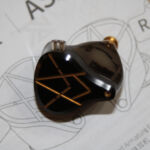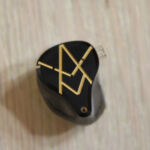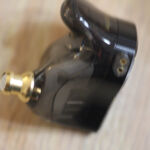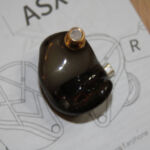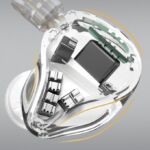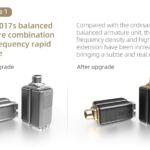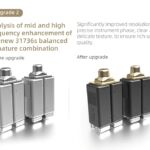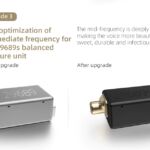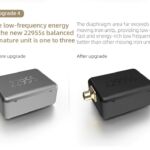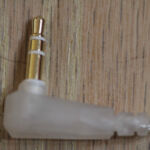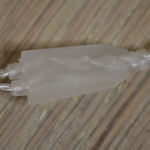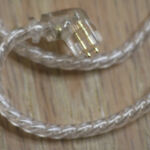KZ ASX
No disclaimer needed. The KZ ASX was purchased at full retail price from an AliExpress store.
Unboxing / Packaging:
Honestly having paid a shade over $100 for these, I anticipated the kit and packaging would be a bit better. They arrived in a flat black box with the KZ logo embossed in satin black at the center and a sticker on the side with the model name and whether or not a mic is included on the cable. No specs are provided anywhere on the package, nor is there a picture of the earpieces or any other indication of the contents of the box. As a matter of fact, nowhere on the package does it identify the contents as an earphone. If I saw this on a store shelf, I’d skip it for lack of details. The box is a book-fold style and lifting the top panel reveals the earpieces and a plaque with the model information on it. Lifting that tray reveals the remainder of the kit which consists of the manual, two additional sets of tips (SML silicones) and the cable. No case, cable tie, foams, or shirt clip is provided which seems a bit thin for a flagship kit. Maybe KZ put all the money into drivers and tuning so I am still hopeful at this point, but it does leave the user feeling a bit underwhelmed.
Build/Fit:
The ASX is a 4 part shell with a metal faceplate in satin black with gold accents, a transparent resin inner shell made in 2 parts and a brass nozzle. Shells are large so will be a problem for those with small ears and will warrant trying before a purchase to be sure they fit. The inner shell has a seam that runs near the inner surface and can be felt with a fingernail. Whether this is a mold seam or a 2 part assembly is debatable but it is clearly visible. The transparent inner shell is somewhat defeated by the sound guide that is opaque plastic and hides most of the internals. Some of the armatures are visible with a large single unit visible as the rear near the raised bi-pin connector and 4 small units visible from the front of the unit. To see the electronics, the faceplate would need to be removed and with it being glued firmly in place I didn’t feel like destroying the earpieces trying to do so. 4 vents are present on the outer shell with 3 in the gold design and a 4th at the bottom of the shell. The 3 on the design are cosmetic only and do not actually penetrate the faceplate while the 4th does indeed function as a vent. Nozzles are a size smaller than typical for KZ so your starline tips won’t fit either. These take Spin-fit CP360 tips or Comply 400 core size. It is also worth noting that nozzles have almost no rake and are fairly short so insertion depth is fairly shallow and isolation is only average as a result. Weight is less than one might expect and as a result they are fairly comfortable (if size isn’t a problem). I did find the ASX somewhat physically fatiguing due to its size and shape and while it wasn’t enough to keep me from continuing to listen, it was enough to be noticeable.
Internals:
The ASX is an all balanced armature affair, but it has pretty much every armature KZ makes stuffed into the shell somewhere. At the low end, a 22955 is used while the mids are served up by a single 29689 and four 31736 that help with upper-mids and lower treble. Highs are handled by four 30017 armatures for a total of 10 per side. Add to that, the fact that all 4 driver types have been updated and tuned specifically for this model, and you have a KZ technology demo in a single in-ear. The drivers are encased in a 3d printed acoustic chamber that provides sound bores between the drivers and the nozzle. The cross-over is a 4 way cross with each armature type handling a specific range and each tuned to mate with the others. Nominal impedance is listed as 20Ω with a sensitivity of 106dB/mW. I found the ASX easy to drive from lower powered sources and while it does scale a good bit qualitatively, quantitatively, it does not need the additional power of higher end sources.
Cable:
The provided cable is silver plated copper and is listed as 100 core in KZ literature. The casing is clear and may eventually give way to green as some earlier models have, but to date, no such corrosion/tarnish has been seen. The Jack is the 90º type that I prefer in a translucent plastic housing with a proper strain relief before the cable exits as a double helix up to the Y shaped splitter. The splitter is the same translucent plastic and in typical KZ style is lower on the cable than I would prefer and has no chin slider to help mitigate its positioning. Above the splitter the wire is a fairly tight twist up to the pre-formed earhooks. The .75mm hooded bi-pin are of the rounded style and have transparent clear plastic housings which makes the L/R designations difficult to see depending on lighting. The cable while functional is not fitting of a flagship in today’s market and won’t be competitive with other makers offerings at the $100 price point. This is one place KZ should have stepped up their game to match the earpieces.
Sound:
Bass:
Sub-bass is not atypical for an all balanced armature model as it has some rumble but lacks that visceral thud a larger dynamic driver can produce. The trade of for that loss of thud is a gain in control. Sub-bass is tight with good textures but, unfortunately, Mid-bass is too forward and detracts from the sub-bass qualities. Mid bass quickly becomes the dominant focus of the ASX as it steps forward and while bleed is kept to a minimum with the driver speed of the BA, it still obscures some of the lower mids due to shear volume. Sad as it has good speed and control and just a voicing choice here that makes the difference. EQ helps bring that early mid-bass into better line but it is a bit too much without it.
Mids:
I guess I should have seen this coming, with one driver to handle mids and 8 to handle upper-mids and treble, but the recess to the lower mids is larger than anticipated and lower vocals sound thinner than realistic and a bit distant as a result. Guitar is reasonably crisp but again not forward in the mix and is overshadowed at times by the mid-bass boost. Lower strings suffer the same fate. The dip in the true mids creates problems for the ASX and makes too many critical elements (strings, vocals, guitars) feel very veiled and distant even in passages where they are the primary focus of the piece. Upper-mids climb some and push female vocals a bit more forward in the mix, but somehow the distance and veil largely remains in play.
Treble:
Lower treble shares the climb of the upper-mids but then becomes a series of minor peaks and valleys rather than a solid plateau and gives the ASX a very odd treble demeanor. After the early emphasis, the treble drops back to a level equal to the mids and falls into that same trap of being too far back and not providing enough energy to make snare rattle less than enthusiastic and cymbals lack enough energy to be convincing. At times cymbals are little more than click in the background due to the tuning of the treble. For a model with 8 of its 10 armatures focused on the upper-mids and treble, this is a massive fail and how this got out of the factory without rethinking the tuning eludes me.
Soundstage / Imaging:
Soundstage is a bit wider than deep with some height but this is deceptive too as not all positions are where you would anticipate. Seating the orchestra is an odd experience as it can be tough to tell where things are coming from. Separation is good, but imaging is off and things move around the stage in fits and starts at times rather than fluid movements through the space. Imaging around center stage is particularly disappointing with a hole at dead center that fails to display movements at all. Layering is good with no tendency to thicken on complex tracks which is a plus but falls short of salvaging the ASX.
Comparisons:
To say the ASX has competition in the market is an understatement. The $100 to $150 price point is arguably the hottest segment of the market with most makers targeting at least one product at this price and often multiple products in the space. Dunu’s titan series all fit in the space as does their new Studio3. BGVP’s latest releases are the Zero and DMG at near this price. Tin Hifi’s has the T4, Moondrop has the Starfield, IBasso has the IT01, NiceHCK recently released another rendition of the NX7 Pro, and TFZ has the No.3, King, and Tequila 1 all in this same space. For KZ to successfully move up into this space, they have to be competitive with at least some of these establish players and to dominate the market like KZ has at lower levels, they need to offer more than these others by enough margin to make the decision easy for the consumer.
Dunu Studio 3
The Studio 3 is a good bit smaller and its all resin shell looks a bit more high-end than the ASX with its mixed component shell. Both are all balanced armature models but the Studio stops at 3 where the ASX adds 7 more. This is a case of more not equally better as the tuning of the Studio 3 is much more even and vocals shine rather then being recessed and veiled on the ASX. Dunu has proved to have considerable prowess in the budget to mid market and the ASX poses no threat to their market share.
BGVP Zero
The Zero is an all metal shell and is considerably smaller and thinner than the ASX so fit issues may favor the Zero for many. The Zero is a hybrid with a dynamic driver and an electret upper end vs the all armature ASX. Starting in the lows, the Zero has more thump and rumble but lacks the control of the ASX which is a bit tighter and cleaner in the lows. From that point up the contest is dominated by the Zero with better mids, less veil and recess and much more open treble with a later roll off and more natural presentation of everything from vocals to strings to cymbals. The Zero isn’t perfect, but when put side by side with the ASX it feels much closer to it.
NiceHCK NX7 Pro
Both have composite shells with metal face plates with the Nx7 pro allowing for changing face plates if desired. The Nx7 pro shell is smaller than the ASX by roughly 25% despite having nearly as many drivers and a large dynamic in the shell. Internals are hybrid (dynamic, 4BA, and Piezo) vs all armature. Tuning filters on the give users some options to adjust the Nx7 which helps with versatility as well. Overall while not a huge fan of the original Nx7 tuning, it is improved with the use of the filters on the Pro model and is considerably better than the ASX as a result.
iBasso IT01
Shell wise, the IT01 is roughly ½ the thickness of the ASX and between ½ and ²⁄3 the size overall. With rounded edges and an almost river-stone sort of shape the IT01 is an easier long term wear shell without fatigue becoming an issue. The IT01 is all resin vs the ASX metal faceplate but both have roughly equal levels of fit and polish. Internally these two have nothing in common with the IT01 being a single 10mm dynamic driver and the ASX sporting 10 balanced armatures. Sound wise, the two are fairly far apart as well. The IT01 has a warm tone with good slam but lacks some detail and has a fairly relaxed treble. The ASX on the other hand sacrifices slam for speed and detail and has better clarity and more air and sparkle at the top. It is not as polite as the IT01 is in that regard, but brings out more of the original recording including whatever mistakes, mixing problems etc may be in the track. Forgiveness of poor material favors the IT01 – detail favors the ASX.
Thoughts / Conclusion:
Well, I had high hopes for this one. So much so that I dropped $100 of my own money rather than wait on a possible sample offering to arrive. My hopes were dashed rather quickly when I began listening and thought I might have one wired wrong as the veil is almost pronounced enough to feel like a reversed phase issue. Even if I could get by the veiled vocals, the treble is just so unnatural that cymbals are almost non-existent in the mix and makes the ASX feel a bit closed in. In the on-going “How many drivers can we stuff in your ear” battle, the ASX stands as a stark reminder that more is not always better and tuning is still a critical component of the design process. I’d like to think that KZ was advancing but of late it seems good models are more happy accidents than improvements in design.
-
Bass - 7/107/10
-
Mids - 4.5/104.5/10
-
Treble - 4.5/104.5/10
-
Soundstage - 6/106/10
-
Imaging - 5/105/10
Summary
Pros: good looking face plate, bass quality is fairly good, more comfortable than expected (size)
Cons: major recess and veil to the mids, lacks treble extension, can’t compete at price-point.


